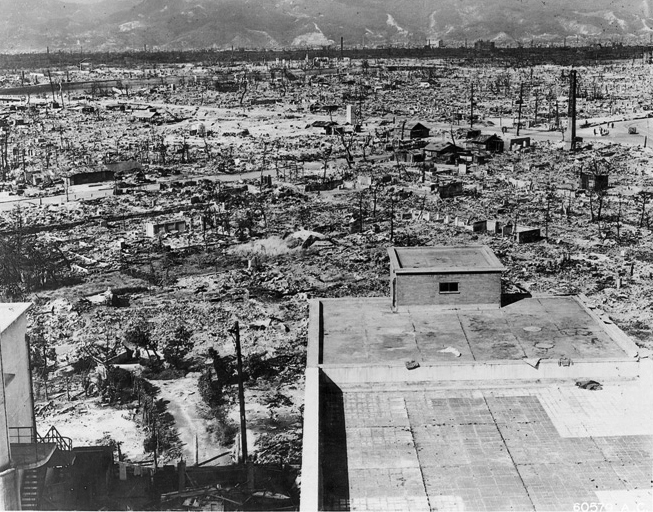
As some readers will probably recognise, the title of this post is a phrase drawn from Herman Kahn’s On thermonuclear war, one of the more depressing texts of the 20th century. Kahn, writing in 1960 when the Cold War was at its height, argued that policymakers should try to limit losses even in the most serious forms of warfare: that there were marked differences between conflicts that resulted in the deaths of two million people and required a one-year economic recuperation, and those that resulted in the deaths of 160 million people and required a 100-year recuperation—not to mention a number of ‘distinguishable’ points along the spectrum between those extremes.
Over recent months there’s been no shortage of commentators telling us that conflict on the Korean peninsula would be ‘tragic’. If by ‘tragic’ they mean ‘costly’, I’m inclined to agree—although Western perceptions of ‘costly’ conflicts seem to have shifted over recent decades, driven in part, no doubt, by the rise of the one-child family. Still, we need to look beyond the adjective; the Kahn aphorism is a reminder that tragedy comes in many forms—and that some tragic outcomes are distinctly preferable to others.
The viability of military options on the Korean peninsula has resurfaced in the wake of North Korea’s latest ballistic missile test. Strategic opinion seems genuinely divided on one critical question: can nuclear deterrence effectively corral North Korea’s growing nuclear arsenal? On one side is a group that believes that even a North Korea with an appreciably bigger nuclear arsenal than the one it now enjoys can be deterred by the classic—and proven—mechanism of nuclear deterrence. On the other side is a group that sees the North Korean nuclear problem as idiosyncratic, and worries that nuclear deterrence might not translate well to our current dilemma.
It’s a critical point. If nuclear deterrence will work in relation to North Korea, we can be more relaxed about the pace and scope of North Korea’s nuclear and missile advances. If it won’t, the requirement to find some other leverage against Pyongyang takes on a degree of urgency.
So what do we know of nuclear deterrence? Sadly, not as much as we’d like. Part of the reason lies with the mechanism itself. As former Israeli foreign minister Abba Eban once said, ‘deterrence … is the science of things that do not occur’. Frankly, we often struggle to accurately attribute causation to events that do occur; doing so in relation to ones that don’t is a much more complex endeavour.
Moreover, although nuclear deterrence has been around for decades, practical experience of its operation is somewhat limited. The bulk of that experience derives from the Cold War, when two heavily armed superpowers built a finely wrought balance of terror. Those superpowers shared a sense of the high cost of great-power war, the resources to throw at command and control problems, a willingness to tolerate each other’s spheres of influence, and an intercontinental separation between their homelands. Most of all they shared an aversion to risk—because both had large equities in the international system.
Yes, other nuclear powers existed alongside the US and the Soviet Union. But the deterrent capabilities of the British and French arsenals were never really tested outside the broader superpower contest. A similar point might be made with regard to China’s nuclear force, deployed in Asia, the secondary theatre of the Cold War. Still, the P5 players all saw themselves as members of an exclusive club—a club which enshrined their status as ‘responsible’ nuclear powers. Those perceptions—plus their shared day-to-day experiences of managing international security crises on the UN Security Council—shaped their dealings with each other.
Of course, the bomb eventually spread beyond the P5. India and Pakistan built arsenals for regional deterrence, as did Israel. And North Korea, a narco-criminal pariah state boasting a record of bad behaviour, eventually pushed its way into the nuclear club. Its doing so has sharpened an important question: is this a club that anyone can join through mere determination to proliferate? (Personally, I’d favour making admission harder, at least to the point where it matches quality preschool enrolment: a country that wants nuclear weapons has to show that it can play nicely with the other kids.)
North Korea is the first of the non-P5 nuclear powers to aspire to intercontinental capabilities. ICBMs matter because they allow Pyongyang to play at the global level, rather than just at the regional level. Deployed in sufficient numbers, ICBMs allow a state with almost no equity in the global order to pull down that order on a day of its choosing.
Perhaps deterrence would stop such an event from occurring. But just how certain can we be of that? Are we basing that judgement simply on the value that Kim Jong-un places on his own life and the survival of his regime? He certainly cares little for his people. He already holds Seoul hostage to his whims, courtesy of North Korean artillery deployed north of the DMZ. We shouldn’t allow him to place much of the world in a similar position courtesy of nuclear-armed ICBMs. If it looks like we’re reaching such a point, we need to think seriously about Kahn’s ‘tragic but distinguishable postwar states’.

